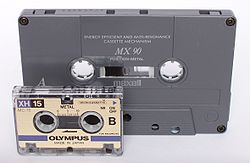This article needs additional citations for verification .(July 2022) |
| | |
 A Microcassette is significantly smaller than a Compact Cassette | |
| Media type | Magnetic cassette tape |
|---|---|
| Encoding | Analog signal |
| Capacity | MC60 (30 min per side at 2.4 cm/s) MC10 MC15 MC30 |
| Read mechanism | Tape head |
| Write mechanism | Magnetic recording head |
| Developed by | Olympus |
| Usage | Dictation, audio storage |
| Released | 1969 |
The Microcassette (often written generically as microcassette) is an analog audio cassette storage format, introduced by Olympus in 1969.
Contents
It has the same width of magnetic tape as the Compact Cassette but in a cassette roughly one quarter the size. By using thinner tape and half or a quarter the tape speed, microcassettes can offer comparable recording time to the compact cassette but in a smaller package. [1] [ citation needed ]






